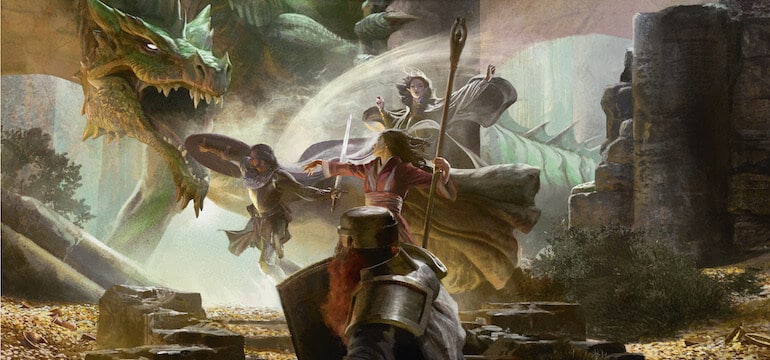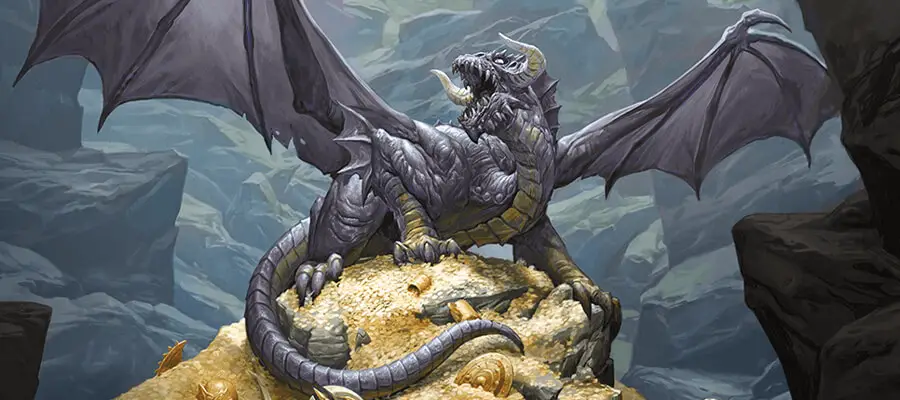Featured image for adventure module session prep is property of Wizards of the Coast in Lost Mine of Phandelver.
Disclaimer: This article contains affiliate links that add gold to our coffers.
Picture this: You’re in the middle of session prep for a 5e adventure module, and you’re not sure what happens next.
You glance down at the book, searching for it—a plot hook, a line of dialogue, a trap’s DC.
In a perfect world, you have clear, concise information at your fingertips. But official campaign modules for Dungeons & Dragons 5th Edition are often written in a free-flowing, narrative style that’s difficult to quickly reference.
This is great for casual consumers who enjoy reading—but not running—official modules, but unhelpful for DMs who expect to run the adventure straight out of the book.
At their best, official modules are disorganized, forcing DMs to kludge together information from multiple sections. At their worst, they’re actively hostile, drowning essential details in a flood of irrelevant information. In all cases, 5e’s lengthy, freewheeling paragraphs can slow the game down to a crawl, forcing DMs to spend precious minutes reading, parsing, and processing the written text.
Fortunately, there’s a better way. With minimal effort and a straightforward three-step process, you can translate official modules into clean and efficient notes for your next session—making for lightning-quick reference times and an improved understanding of the campaign itself. The steps are simple:
- Read the Text
- List Component Parts
- Reorganize Area notes
Step One: Read the Text
5e modules aren’t light reading. At several hundred pages each, they can be difficult to plough through. However, you should always have at least a basic understanding of the full adventure before settling into the campaign.
As you prepare for an upcoming session, however, you’ll want to get more specific. Start with the area that’s currently the most relevant to your campaign (i.e., the place your players have first on their to-do list). If you’re using community supplements, plan to peruse them after reviewing the original material.
This might sound like a tall order if your players plan to visit a sandbox-y, open-world area (the town of Vallaki in Curse of Strahd comes to mind), but you can make your life easier by asking your players directly (OOC) what they hope to do and where they plan to go.
Once you’ve reviewed this first area’s material, you might want to re-read the next section your players plan to visit. This might be an area that’s currently on their itinerary, or it might be an area that the first area will hook them to.
Don’t drive yourself crazy with recursion—if your players are at the entrance of a good-sized dungeon and they’ve pre-committed to exploring it, that’s likely all you’ll need to review to prepare. Don’t let your reading branch too many times, either. If a single area has many plot hooks (e.g., a job board in the local inn), remove or postpone any plot hooks that you’d rather your players avoid for the moment.
Step Two: List Component Parts
Now, it’s time to start breaking that material down. Let’s start with the Lazy DM’s six categories of content:
- Locations. The locations your PCs are likely to visit.
- Characters. The NPCs your PCs are likely to encounter.
- Scenes. Specific scenarios that are likely to occur.
- Secrets. Tidbits of information you’d like your PCs to learn.
- Monsters. Enemies you expect your PCs to fight.
- Loot. Rewards you expect your PCs to gain.
Go back through your reading and jot down brief (1-3 sentence) descriptions for each story element that appears, placing each element in its corresponding category. You don’t have to be comprehensive—just reasonably thorough.
For example, the first session for Lost Mine of Phandelver might look like this:
Locations.
- Goblin Ambush. A dirt road surrounded by thickets. Four goblins lie in wait. A path to the goblins’ hideout lies nearby.
- Hidden Trail. A trail that leads to the Cragmaw hideout. Contains a pit trap and a net trap.
- Goblin Blind. A thicket provides cover to two goblin guards. A bubbling creek runs from the mouth of a nearby cavern.
- Wolves’ Den. A small side-cavern holding two wolves tied to a post. A rubbish chute leads up to Klarg’s lair.
- Overpass. A rickety wooden bridge overlooking the dark cavern corridor. A stream runs down the western side, flooding if the goblins release the northern dams. A goblin stands guard.
- Dammed Pools. Twin pools dammed by three Cragmaw goblins. A waterfall fills the pools from the northeastern side. A narrow corridor leads to the sentry’s bridge, and stone steps ascend to Klarg’s lair.
Characters.
- Cragmaw Goblins. A band of greedy, stubborn, but cowardly goblin bandits. Its members love gold and hate Klarg.
- Gundren Rockseeker. A dwarven prospector and the PCs’ employer. Kidnapped by goblins.
- Sildar Hallwinter. A knight and Gundren’s bodyguard. Kidnapped by goblins.
Scenes.
- Ambush! As the PCs investigate Gundren and Sildar’s dead horses on the road, they’re ambushed by goblins.
- Sneaking In. The PCs must distract or incapacitate the goblin sentries outside of the cave—or risk raising the alarm.
- Hungry Wolves. If the PCs linger by the wolves’ den without feeding them, the wolves free themselves and attack!
- Silent Eyes. If the PCs aren’t sneaky as they enter the cavern, the sentry on the overpass alerts the goblins at the pools, releasing the flood!
Secrets.
- Klarg. The goblins are led by a bugbear named Klarg—a brute of a bugbear who believes himself to be a mighty warlord just beginning his career of conquest. He is not entirely sane and cares for no creature in the hideout, save for himself and his mangy pet wolf, Ripper.
- Gundren’s Fate. Klarg received a messenger goblin from King Grol a few days ago, who told him that someone named the Black Spider was paying the Cragmaws to watch out for the dwarf Gundren Rockseeker, capture him, and send him and his possessions to King Grol. Klarg followed his orders, and Gundren was recently ambushed and taken to Cragmaw Castle with his personal effects, including a map.
- The Cragmaw Tribe. Klarg answers to King Grol, chief of the Cragmaw Tribe.
- Klarg’s Treasure. Klarg recently led the goblins to ambush a caravan of mercantile weapons and trade goods coming down the Triboar Trail. The loot is stashed in his lair.
Monsters.
- Goblin. If close, attack with scimitar; if distant, take cover and attack with shortbow.
- Net Trap. Ensnares PCs unless noticed (passive Perception 12).
- Pit Trap. PCs fall in unless noticed (passive Perception 12; 1d6 bludgeoning damage).
- Wolf. Attack with bite and drag away to eat.
- Flood Trap. DEX DC 14 or 2d6 bludgeoning damage and washed out of the cave.
Loot.
- Each goblin carries a pouch containing 1d4 sp plus 2d6 cp.
Of these categories, pay special attention to Scenes and Secrets. When it comes to scenes, it’s tempting to expect certain scenarios to play out in certain ways—but players are rarely so predictable. Instead, prep situations, not plots, and ensure each potential scene has a strong dramatic question that drives the narrative forward.
When it comes to secrets, information is power. By limiting or manipulating the knowledge your players receive, you can steer them in certain directions, ensuring that they never stray far from the content you’ve prepped. If you feel that a secret introducing a new area or quest lacks a strong hook, make sure to enhance it with urgency, clarity, and purpose.
Step Three: Reorganize Area Notes
It’s vital to keep distinct types of information separate, ensuring that you can parse details from your notes at a glance. Each time you prepare an area, you can sort its narrative elements beneath the following subheadings:
- Introduction. The boxed text that describes the area, plus the area’s purpose and history. Additional technical notes (e.g., soundtrack or ambience).
- Characters. A brief description of each NPC inhabiting the area, including personality, goals, and physical attributes.
- Details. A brief description of each object or hazard within the room (e.g., the contents of a chest).
- Developments. A brief description of each scene that the players can trigger through their actions (e.g., a secret door or hidden trap).
- Combat. A brief description of each combatant’s tactics, if present.
Take the narrative elements you organized in Step Two. For each area your players plan to visit, fill out the template above using those elements. If you need, you can cross-reference those notes with the corresponding pages in the module, making sure that you’ve gotten everything down.
The end product might look something like this:
Area 5. Overpass
The stream passage continues up beyond another set of uneven steps ahead, bending eastward as it goes. A waterfall sounds out from a larger cavern somewhere ahead of you. A rickety bridge spans the passage, connecting two tunnels that are twenty feet above the stream.
The goblins have set up a bridge guard post here.
Characters.
- Goblin Sentry. One lazy and inattentive goblin stands watch from its hiding place atop the bridge.
Details.
- The Bridge. The bridge is twenty feet above the cavern floor. A PC can climb the (rough, but slick with spray) cavern walls to reach it. (Athletics DC 15). The bridge has AC 5 and 10 HP, and collapses if destroyed. (DEX DC 10 for each creature atop it or fall, taking 2d6 bludgeoning damage and landing prone).
Developments.
- Sharp Eyes. If a PC has a passive Perception of 16 or makes a DC 16 Perception check, they spot the goblin atop the bridge.
- Sneaking Past. If the PCs are not using light sources, they can make a group Stealth check (DC 9) to sneak past the goblin.
- Goblin Alert! If the PCs fail their Stealth check or use light sources, the goblin notices them, then signals the goblins in Area 7 (Twin Pools Cave) to release the flood. The goblins roll initiative. The following round, on the goblins’ initiative, a water surge pours from Area 7 (“The passage is suddenly filled with a mighty roar, as a huge surge of rushing water pours down from above!”). All creatures in the corridor below the bridge must make a DC 10 DEX saving throw to avoid the flood; on a failure, a creature can make a DC 15 STR saving throw to hold on. On a failure, the creature is knocked prone and washed out of the cave, taking 1d6 bludgeoning damage on the way.
- Back Again? If some of the PCs evade the flood, or if the party returns a second time and fails to sneak past the goblin on the bridge, it signals for the goblins in Area 7 to release the second flood.
Combat.
- Goblin Sentry. On its turns, the goblin attacks with its shortbow (with advantage if it successfully hid the prior round), then takes the Hide action as a bonus action (using its Nimble Escape feature)
Conclusions
Every DM’s prep process is different. Even so, it’s my hope that this brief guide can help you create a helpful, reliable structure for the notes you bring to your sessions. Official modules can provide a wealth of creative ideas and inspiration that can enrich any campaign—but it’s my hope that this method can help you unlock their true potential, allowing you to explore all of the material with none of the stress.
About the Author: DragnaCarta is a guest writer for FlutesLoot.com and a veteran DM with 12+ years of experience. He is the author of the popular “Curse of Strahd: Reloaded” campaign guide, a moderator of /r/CurseOfStrahd, and the Dungeon Master and director for the Curse of Strahd livestream “Twice Bitten.” You can get his D&D hot takes and commentary by following his Twitter, or get personal RPG mentoring plus early access to projects by joining his Patreon.
Cast Message in the comments section below to ask DragnaCarta about this topic. You can find other articles by DragnaCarta on FlutesLoot.com.



